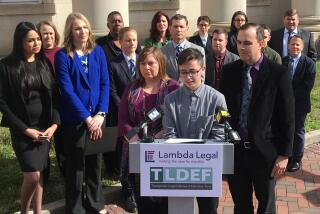Pentagon Takes Its Robotic Vehicle Challenge to the Streets
After robotic vehicles succeeded last year in navigating a grueling desert obstacle course, the Pentagon has now come up with an even hairier competition -- navigating city streets.
The challenge was issued Monday by the Defense Advanced Research Projects Agency, which for the last two years has sponsored a $2-million contest to find the toughest and most cunning autonomous robotic vehicle.
The new DARPA Grand Challenge competition, set for November 2007, will require the robotic vehicles to basically drive better than many people, demonstrating the ability to merge politely into moving traffic, observe the right-of-way at intersections, flash appropriate turn signals and avoid maiming pedestrians.
Competitors are already worried.
Sebastian Thrun, the computer scientist who led Stanford University’s winning team last year, said he was uncertain if any car could finish.
“People are going to be surprised how difficult it is,” he said.
The goal of the Grand Challenge is to help speed the development of military vehicles that can make their way through hostile territory without human control, meeting a congressional mandate that 30% of the military’s vehicle fleet be robots by 2015.
The urban environment will be a more realistic test for autonomous robots that the U.S. military hopes to use in its operations, said Jan Walker, a DARPA spokeswoman.
“If the U.S. military were to use autonomous ground vehicles to accomplish a resupply mission, for example, it is highly unlikely that the vehicle’s route will be completely clear of other vehicles or that it will have no traffic lights,” she said.
“Or the route could be blocked by debris or ambush, and to successfully accomplish its mission, the autonomous vehicle would have to turn around and take a different route without waiting for instructions.”
Thrun said it all added up to one enormous engineering problem.
The last “Grand Challenge proved that robots can drive relatively fast and negotiate complex terrain,” he said. “But now the robot will have to understand there’s a car over here, pulling out, or using a turn signal. If it doesn’t understand that a car drives this way, it will be dead.”
The first Grand Challenge took place in 2004. No vehicle made it through the entire 142-mile course from Barstow to Primm, Nev. Some crashed through fences or got lost. The best entry drove for about seven miles before its front wheels caught fire.
Last year, in a slightly modified 131-mile course that looped around Primm, five teams finished the race. Stanford’s winning Volkswagen Touareg, dubbed “Stanley,” muscled through the route in just under seven hours.
The new challenge will take place on a mock urban set complete with buildings, intersections, fire hydrants and light poles.
The vehicles will have to finish the 60-mile course -- about the distance from downtown Los Angeles to San Bernardino -- in less than six hours.
The cars will also be judged on how safely they complete the task.
Thrun thinks Stanford may have a fighting chance because his team has been working for the last six months on a robotic car that can drive itself from San Francisco to Los Angeles.
More to Read
Start your day right
Sign up for Essential California for news, features and recommendations from the L.A. Times and beyond in your inbox six days a week.
You may occasionally receive promotional content from the Los Angeles Times.






